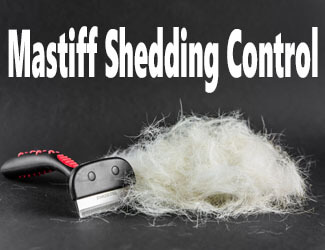Mastiff Hip Dysplasia Causes
Symptoms Treatment
by Ken Alden
Does your Mastiff appear to take longer than necessary when getting on his feet? Are the hips stiff and the hind legs weak? If you answered yes to these questions, your furry companion could be suffering from a condition that's quite common to Mastiffs.
Hip dysplasia in Mastiffs is a genetic condition that originates from an improperly formed hip. This hip deformity occurs as your puppy grows and results in a loose joint. Due to this, the dog's leg bone moves about as it rubs and grinds, leading to painful wear and tear and, at times, lameness.
In this article, you will discover all you need to know about hip dysplasia in Mastiffs, including the cause, symptoms, and how to treat it. Also, you will find information on how to prevent the ailment. Read More Below...
Pro-tip: Ever try lifting a Mastiff? Their weight can hurt not only your back but their joints when they hop down from cars, sofas or even your bed. To protect your back and theirs check out the best Mastiff ramps on Amazon.com now.

What Is Hip Dysplasia?
Hip dysplasia is a deformity that occurs on the hip joint (a ball and socket joint).
Under normal circumstances, as your Mastiff puppy grows, the ball - at the head of the thigh bone - and socket -located at the pelvis - also develop at the same rate. However, this doesn't always happen.
When the ball and socket grow at different rates, the joint becomes loose, causing the Mastiff's leg bone to move around freely. This rubbing and grinding (as opposed to sliding smoothly) wear out the joint, and eventually, it loses its functionality. Later on, this joint laxity could lead to osteoarthritis.
What Causes Mastiff Hip Dysplasia?
Besides genetics, factors such as improper diet and exercise, excessive growth rate, hormones, muscle mass, and the environment can make your Mastiff susceptible to developing hip dysplasia. But, without abnormal DNA, these other factors might have negligible or no influence at all. Causes Symptoms Treatment
The condition can develop from as early as five months and worsen as your puppy grows older. It could also wait until your dog is geriatric though the disease is most noticeable in mature (1-2 years) or senior Mastiffs.
Pro-tip: Mastiff anxiety, aggression, destructive chewing, jumping up, fearfulness, and other behaviors can be controlled with the right training program.
Here’s a great course that
addresses these issues along with many other dog training basics: Check it out now!
Mastiff Hip Dysplasia Symptoms
The extent of arthritic changes determines the level of lameness that occurs. Let me explain.
While some dogs may not show any visible signs of the disease, others might experience a lot of pain and even become lame.
You see, some Mastiffs exhibiting mild hip dysplasia (as seen on x-rays) may develop slight arthritis without any clinical signs until much later. Plus, while the condition might begin in puppyhood, most dogs develop clinical symptoms when they get older.
To sum it up, it might take several years of gradual bone degeneration for your Mastiff to become symptomatic.
What signs should you look out for then?
As mentioned earlier, some cases of hip dysplasia might be very mild and show no symptoms. However, in severe cases, you will notice the below symptoms:
- Stiff or sore hips
- A reluctance to participate in exercise activities
- Difficulty in climbing stairs or standing on hind legs
- Limping, wobbly legs, or a bunny hop gait - both hind feet advance at the same time
- Unwillingness to rise if the dog is sited or lying prone
Mastiff Hip Dysplasia Treatment
If your Mastiff is showing the above symptoms, take him to see a vet. To diagnose the problem, the vet will perform a physical examination. Clinical signs and pronounced joint laxity will usually indicate hip dysplasia.
Additionally, radiographs and manual tests on the dog's hips may be necessary. In most cases, the vet carries out a hip radiograph under general anesthetic.
The treatment for hip dysplasia depends on your Mastiff's symptoms and level of discomfort. However, it's important to note that since the condition is due to a genetic defect, there's no medication to prevent its development.
A Disclaimer: Although we're Mastiff lovers like you, we are NOT veterinarians. If your Mastiff has any health issues we strongly recommend you contact your veterinarian as they are the best ones to advise you on any health related issues.
Nevertheless, there are several effective non-steroidal anti-inflammatory drugs (NSAIDs) with minimal side effects. There are surgical options for extreme cases, some of which include total hip replacement or femoral head ostectomy (FHO).
Your Mastiff's condition, age, and lifestyle determine the choice of surgery. Besides, your veterinarian will advise you on the best option for your dog.
Give your Mastiff glucosamine, chondroitin sulfate, and omega-3 fatty acid nutritional supplements that have your vets' approval. If the condition is painful, regular polysulfated glycosaminoglycan injections are beneficial.
High on the list of recommendations is a good exercise program. While your Mastiff should avoid vigorous exercises like running for miles or jumping, 20-minute daily walks, short runs, or swimming are okay. Besides, they are excellent in strengthening the muscles around the hip joint.
Ultimately, the best mode of treatment is a combination of several interventions. These include: Mastiff hip dysplasia causes symptoms treatment
- A healthy diet
- Massage and exercise
- Maintaining an ideal weight
- A warm, dry sleeping area away from damp and chilly weather
- Pain-relieving medication, joint fluid modifiers, and joint supplements to assist in managing the condition
The vet will also advise on suitable prescription drugs and an effective pain-relieving program that will work for your dog.
Pro-tip: Mastiff's (and their owners) love dog crates…and for good reasons. Crates keep dogs from mischief while you're away, are perfect for house training, for traveling by car, and provide the dog a place to de-stress. Check out the best Mastiff crates on Amazon.com now.
Can Hip Dysplasia Be Prevented?
Hip dysplasia is common in larger dog breeds - above 50 lbs (22 kg) - such as Mastiffs, Bulldogs, Rottweilers, and Retrievers. Hence, as your Mastiff puppy grows, try and maintain him at an average, lean weight.
While not all instances of this condition can be avoided, below are useful suggestions that are helpful in its prevention: Causes Symptoms Treatment
- Weight management - Avoid overfeeding your puppy. Instead, opt for specialty diets formulated for large breeds like your Mastiff. If your Mastiff is overweight, consider a weight loss program to reduce undue stress on the hip joints.
- Physical therapy - When included in the treatment regimen, physical therapy proves to be highly effective. It can also help improve your Mastiff's quality of life, thus making him more comfortable.
- Breed screening - Breeders can help prevent hereditary hip dysplasia by screening their breeding Mastiffs for this condition. This exercise can help confirm their dogs' hip status, ensuring they only breed Mastiffs with normal grade hip joints or higher. Mastiff hip dysplasia causes symptoms treatment
Alternative Treatments
These include acupuncture, stem cell treatments, and traditional Chinese medicine. Their success rate varies, and though encouraging, there's a need for further research to confirm their effectiveness.
Joint Supplements
Joint supplements are beneficial when used in early intervention as well as through progression to arthritis. This is because they:
- Help minimize inflammation
- Make bones stronger, repair impaired tissues and rebuild muscular tissues
- Aid in the formation of cartilage as well as lubrication
- Defend against harmful oxidation
Large breed dog foods contain joint supplements like glucosamine. This supplement helps alleviate joint damage symptoms by assisting in repairing articular cartilage - forming a cushion between joints.
Chondroitin offers similar benefits to glucosamine and is thus useful for treating joint issues. What's more, both supplements have no known negative effects.
Your vet will most likely recommend glucosamine and chondroitin as part of the treatment plan if he diagnoses your Mastiff with arthritis. Though research on these supplements is limited, they may help in hip dysplasia management.
Below are joint supplements that come highly recommended:
- Nutramax Cosequin Strength Joint Supplement - This is the #1 vet-recommended joint health supplement. It contains the top three ingredients for improved joint health and reduced inflammation - glucosamine, chondroitin, and MSM -. The powerful formulation is ideal for protection against joint damage, while the tasty chews are easy to use.
- Lintbells YuMOVE Dog Essential Hip and Joint Supplement - YuMove contains glucosamine and green-lipped mussel, which help support your Mastiff's joint structure. It also boasts manganese, which aids collagen formation and helps maintain healthy joints. Lastly, Omega-3 and vitamin C soothe stiff joints and maintain joint mobility.
- Infinite Pet Supplements Hip & Joint Supplement for Dogs - This supplement combines ingredients that support joint-healing such as glucosamine with turmeric. The latter contains powerful anti-inflammatory properties that aid in reducing the effects of arthritis and weight control. This formula is also excellent for restoring damaged tissue.
Should I Consider Health Insurance for My Mastiff?
The beauty of pet insurance is that it gives you the chance to make the best choice for your Mastiff rather than the most affordable one in case of an emergency. Besides, it helps you avoid paying hefty fees during routine vet visits. It's, therefore, a good idea to consider investing in such a program.
See our comparisons of the top 3 pet insurance carriers for some great deals and coverage for low cost. Causes Symptoms Treatment
Mastiff Hip Dysplasia Causes Symptoms Treatment...Final Thoughts
Hip dysplasia is a painful condition that could result in lameness for your beloved Mastiff. However, with the right information, your dog can live a healthy and comfortable life. Mastiff hip dysplasia causes symptoms treatment
To improve your Mastiff's quality of life, consider pet insurance. Hip dysplasia notwithstanding, large breeds like Mastiffs are prone to expensive health problems. But pet insurance will give you peace of mind and help you manage expenses related to tests, vaccinations, or annual vet exams.
Return To The Top Of This Mastiff Hip Dysplasia Causes Symptoms Treatment Page

About the Author...
Ken Alden, a dedicated Mastiff owner for over eight years, is acclaimed for his expertise in care, grooming, and training. Read more About Me and my dog Shadow.
- Mastiff Guide Home ›
- Mastiff Care Information Guides ›
- Mastiff Hip Dysplasia Causes Symptoms And Treatment






